engine Lancia Ypsilon 2012 Owner handbook (in English)
[x] Cancel search | Manufacturer: LANCIA, Model Year: 2012, Model line: Ypsilon, Model: Lancia Ypsilon 2012Pages: 307, PDF Size: 13.3 MB
Page 181 of 307

❒if a pressure value of at least 1.8 bar is detected,
restore the correct pressure (with the engine
running and the handbrake engaged), resume
driving and drive with care to nearest Lancia
Dealership.
WARNING
Inform the dealership that the tyre
has been repaired using the tyre
quick repair kit. Give the instruction booklet
to the personnel charged with handling the
treated tyre.
CHECKING AND RESTORING TYRE
PRESSURE
The compressor can also be used to check and, if
necessary, adjust the tyre pressure. Release quick
connector A fig. 127 and connect it directly to
the valve of the tyre to be inflated.
REPLACING THE BOTTLE
Proceed as follows:
❒disconnect connection A fig. 128;
❒turn the cylinder to be replaced anticlockwise
and raise it;❒fit the new cylinder and turn it clockwise;
❒connect connection A to the cylinder and insert
the transparent pipe B into its housing.
fig. 127
L0F0180
fig. 128
L0F0008
179GETTING TO KNOW
YOUR CAR
SAFETY
STARTING AND
DRIVING
WARNING LIGHTS
AND MESSAGESIN AN EMERGENCYSERVICING AND
MAINTENANCE
TECHNICAL
SPECIFICATIONS
INDEX
Page 192 of 307

WARNING
If a general protective fuse for safety
systems (airbag system, braking
system), power unit systems (engine system,
transmission system) or steering system
intervenes, contact a Lancia Dealership.
FUSE LOCATION
Engine compartment fuse box
This is located next to the battery: to access fuses
fig. 154 proceed as follows:
❒move the cover A fig. 152 aside;
❒undo screw A fig. 153, release tabs B and
remove cover C by pulling upwards.The number identifying the electrical component
corresponding to each fuse is shown on the cover.
After replacing the fuse, make sure that you
have closed cover C correctly on the fuse box.
If you need to wash the engine
compartment, take care not to directly
hit the fuse box and the window wiper
motors with the water jet.
fig. 152
L0F0170
fig. 153
L0F0094
190
GETTING TO KNOW
YOUR CAR
SAFETY
STARTING AND
DRIVING
WARNING LIGHTS
AND MESSAGESIN AN EMERGENCYSERVICING AND
MAINTENANCE
TECHNICAL
SPECIFICATIONS
INDEX
Page 197 of 307
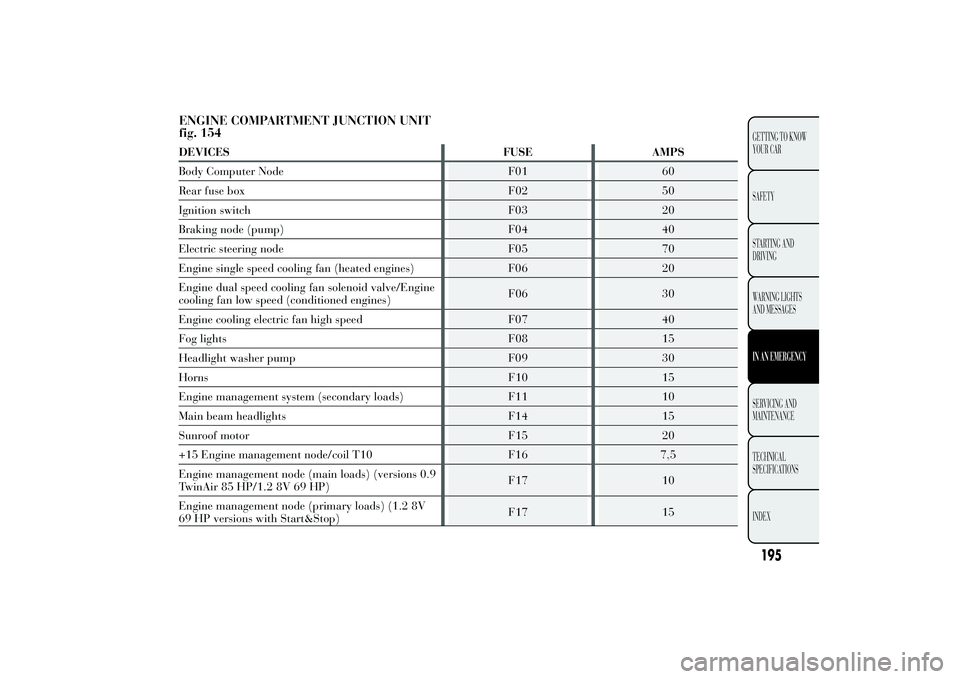
ENGINE COMPARTMENT JUNCTION UNIT fig. 154
195GETTING TO KNOW YOUR CAR SAFETYSTARTING AND DRIVING WARNING LIGHTS AND MESSAGESIN AN EMERGENCYSERVICING ANDMAINTENANCE TECHNICAL SPECIFICATIONS INDEX DEVICES FUSE AMPS Body Computer Node F01 60Rear fuse box F02 50Ignition switch F03 20Braking node (pump) F04 40Electric steering node F05 70Engine single speed cooling fan (heated engines) F06 20Engine dual speed cooling fan solenoid valve/Engine cooling fan low speed (conditioned engines)
F06 30
Engine cooling electric fan high speed F07 40 Fog lights F08 15Headlight washer pump F09 30Horns F10 15Engine management system (secondary loads) F11 10Main beam headlights F14 15Sunroof motor F15 20+15 Engine management node/coil T10 F16 7,5Engine management node (main loads) (versions 0.9 TwinAir 85 HP/1.2 8V 69 HP)
F17 10
Engine management node (primary loads) (1.2 8V 69 HP versions with Start&Stop)
F17 15
Page 198 of 307
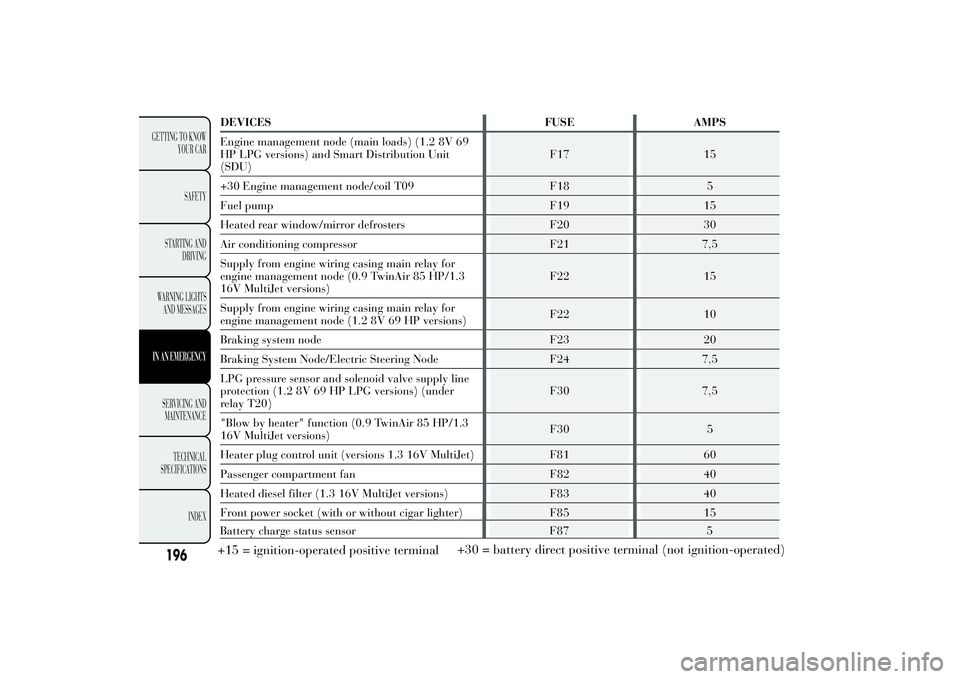
196
GETTING TO KNOW
YOUR CAR SAFETY
STARTING AND
DRIVING
WARNING LIGHTS AND MESSAGESIN AN EMERGENCYSERVICING AND MAINTENANCE TECHNICAL
SPECIFICATIONS
INDEX
DEVICES FUSE AMPS Engine management node (main loads) (1.2 8V 69 HP LPG versions) and Smart Distribution Unit(SDU)
F17 15
+30 Engine management node/coil T09 F18 5 Fuel pump F19 15Heated rear window/mirror defrosters F20 30Air conditioning compressor F21 7,5Supply from engine wiring casing main relay for engine management node (0.9 TwinAir 85 HP/1.316V MultiJet versions)
F22 15
Supply from engine wiring casing main relay for engine management node (1.2 8V 69 HP versions)
F22 10
Braking system node F23 20 Braking System Node/Electric Steering Node F24 7,5LPG pressure sensor and solenoid valve supply line protection (1.2 8V 69 HP LPG versions) (underrelay T20)
F30 7,5
"Blow by heater" function (0.9 TwinAir 85 HP/1.3 16V MultiJet versions)
F30 5
Heater plug control unit (versions 1.3 16V MultiJet) F81 60 Passenger compartment fan F82 40Heated diesel filter (1.3 16V MultiJet versions) F83 40Front power socket (with or without cigar lighter) F85 15
Battery charge status sensor F87 5+15 = ignition-operated positive terminal +30 = battery direct positive terminal (not ignition-operated)
Page 199 of 307

INSTRUMENT PANEL FUSE BOX
fig. 156DEVICES FUSE AMPS
Free F12 -
+15 headlight alignment corrector F13 5
+15 ignition-operated control with inhibition during
engine startingF31 5
Free F32 -
+30 F36 10
+15 switch on brake pedal (NO) F37 7,5
Door central locking F38 20
Two-way windscreen washer pump F43 20
Front electric window (driver side) F47 20
Front electric window (passenger side) F48 20
+15 F49 7,5
+15 F50 7,5
+15 F51 5
+30 F53 7,5+15 = ignition-operated positive terminal
+30 = battery direct positive terminal (notignition-operated)
197GETTING TO KNOW
YOUR CAR
SAFETY
STARTING AND
DRIVING
WARNING LIGHTS
AND MESSAGESIN AN EMERGENCYSERVICING AND
MAINTENANCE
TECHNICAL
SPECIFICATIONS
INDEX
Page 204 of 307

WARNING
Before towing, turn the ignition key to
MAR and then to STOP without
removing it. The steering column will
automatically lock when the key is removed
and the wheels cannot be steered.
WARNING
Before tightening the hook clean the
threaded housing thoroughly. Make
sure that the hook is fully fastened in the
housing before towing the car.
WARNING
Whilst towing, remember that as the
assistance of the brake servo and
the electric power assisted steering is not
available, greater force needs to be exerted
on the brake pedal and more effort is
required on the steering wheel. Do not use
flexible cables when towing and avoid jerky
movements. During towing, make sure that
the trailer hitch does not damage any
components it is touching. When towing the
car, it is compulsory to respect specific
highway code regulations relating to the tow
hook and procedures for towing on the
road. Do not start the engine while towing
the car.
fig. 161
L0F0022
202
GETTING TO KNOW
YOUR CAR
SAFETY
STARTING AND
DRIVING
WARNING LIGHTS
AND MESSAGESIN AN EMERGENCYSERVICING AND
MAINTENANCE
TECHNICAL
SPECIFICATIONS
INDEX
Page 207 of 307
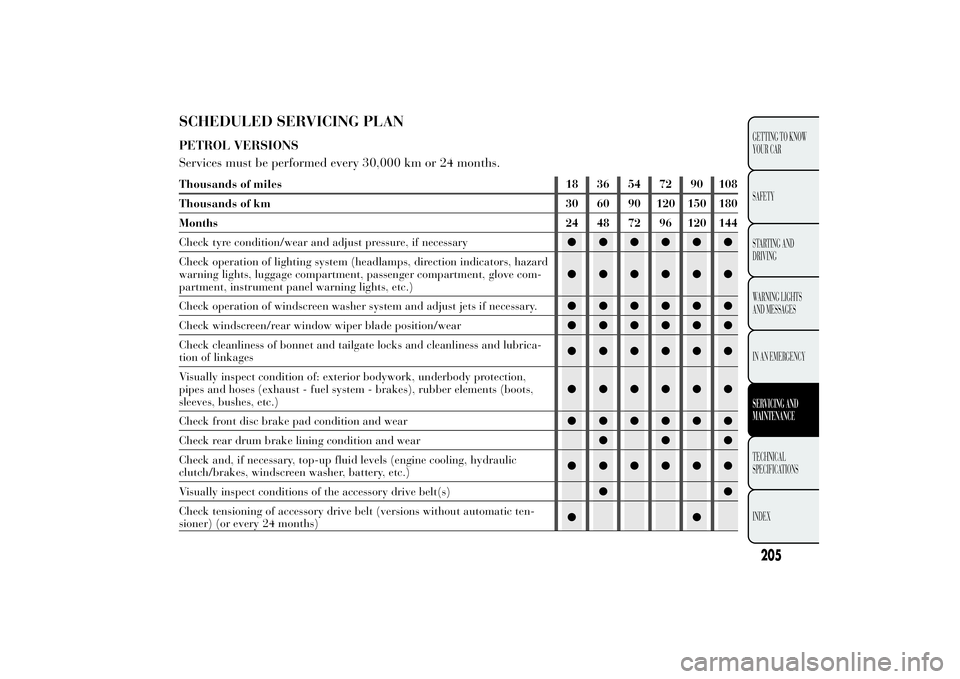
SCHEDULED SERVICING PLANPETROL VERSIONS
Services must be performed every 30,000 km or 24 months.Thousands of miles 18 36 54 72 90 108
Thousands of km 30 60 90 120 150 180
Months 24 48 72 96 120 144
Check tyre condition/wear and adjust pressure, if necessary●●●●●●
Check operation of lighting system (headlamps, direction indicators, hazard
warning lights, luggage compartment, passenger compartment, glove com-
partment, instrument panel warning lights, etc.)●●●●●●
Check operation of windscreen washer system and adjust jets if necessary.●●●●●●
Check windscreen/rear window wiper blade position/wear●●●●●●
Check cleanliness of bonnet and tailgate locks and cleanliness and lubrica-
tion of linkages●●●●●●
Visually inspect condition of: exterior bodywork, underbody protection,
pipes and hoses (exhaust - fuel system - brakes), rubber elements (boots,
sleeves, bushes, etc.)●●●●●●
Check front disc brake pad condition and wear●●●●●●
Check rear drum brake lining condition and wear●●●
Check and, if necessary, top-up fluid levels (engine cooling, hydraulic
clutch/brakes, windscreen washer, battery, etc.)●●●●●●
Visually inspect conditions of the accessory drive belt(s)●●
Check tensioning of accessory drive belt (versions without automatic ten-
sioner) (or every 24 months)●●
205GETTING TO KNOW
YOUR CAR
SAFETY
STARTING AND
DRIVING
WARNING LIGHTS
AND MESSAGES
IN AN EMERGENCYSERVICING AND
MAINTENANCETECHNICAL
SPECIFICATIONS
INDEX
Page 208 of 307
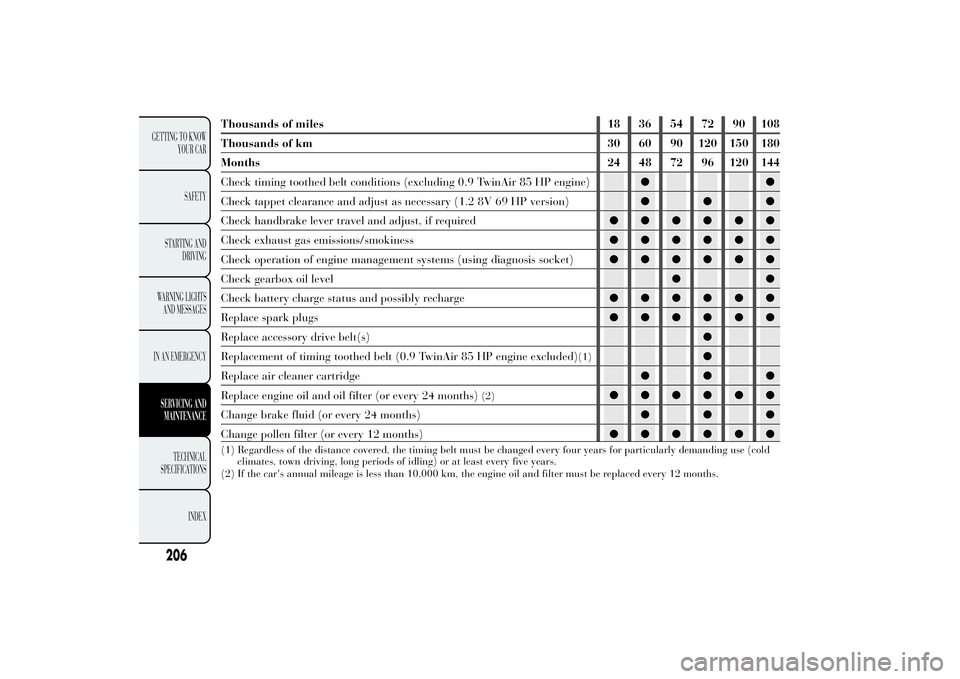
Thousands of miles 18 36 54 72 90 108
Thousands of km 30 60 90 120 150 180
Months 24 48 72 96 120 144
Check timing toothed belt conditions (excluding 0.9 TwinAir 85 HP engine)●●
Check tappet clearance and adjust as necessary (1.2 8V 69 HP version)●●●
Check handbrake lever travel and adjust, if required●●●●●●
Check exhaust gas emissions/smokiness●●●●●●
Check operation of engine management systems (using diagnosis socket)●●●●●●
Check gearbox oil level●●
Check battery charge status and possibly recharge●●●●●●
Replace spark plugs●●●●●●
Replace accessory drive belt(s)●
Replacement of timing toothed belt (0.9 TwinAir 85 HP engine excluded)
(1)
●
Replace air cleaner cartridge●●●
Replace engine oil and oil filter (or every 24 months)
(2)
●●●●●●
Change brake fluid (or every 24 months)●●●
Change pollen filter (or every 12 months)●●●●●●
(1) Regardless of the distance covered, the timing belt must be changed every four years for particularly demanding use (cold
climates, town driving, long periods of idling) or at least every five years.
(2) If the car's annual mileage is less than 10,000 km, the engine oil and filter must be replaced every 12 months.
206
GETTING TO KNOW
YOUR CAR
SAFETY
STARTING AND
DRIVING
WARNING LIGHTS
AND MESSAGES
IN AN EMERGENCYSERVICING AND
MAINTENANCE
TECHNICAL
SPECIFICATIONS
INDEX
Page 209 of 307
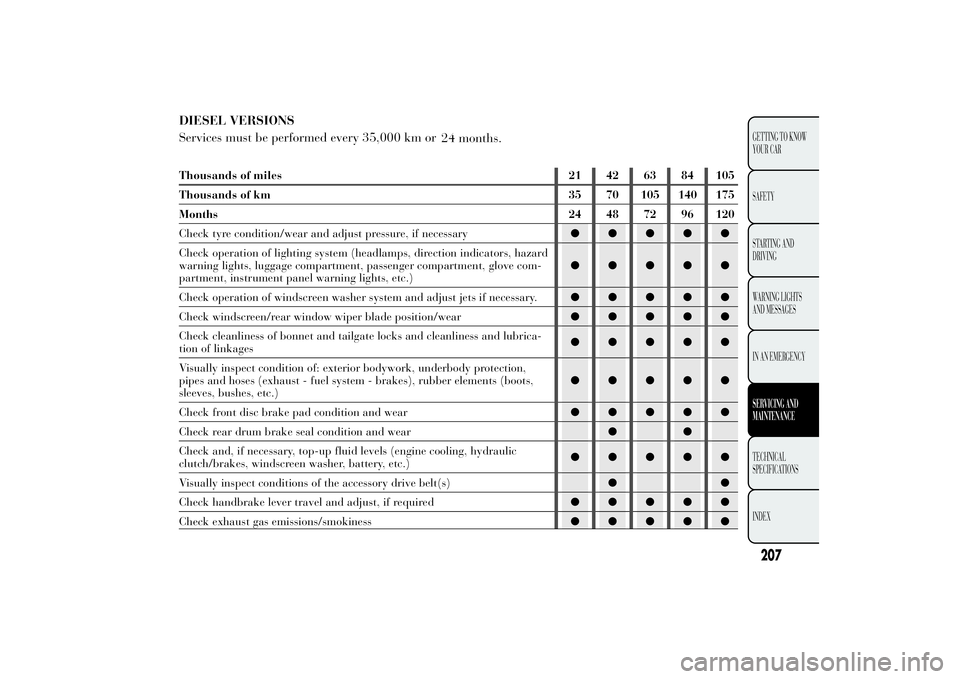
DIESEL VERSIONS
Services must be performed every 35,000 km or
24 months.Thousands of miles 21 42 63 84 105
Thousands of km 35 70 105 140 175
Months 24 48 72 96 120
Check tyre condition/wear and adjust pressure, if necessary●●●●●
Check operation of lighting system (headlamps, direction indicators, hazard
warning lights, luggage compartment, passenger compartment, glove com-
partment, instrument panel warning lights, etc.)●●●●●
Check operation of windscreen washer system and adjust jets if necessary.●●●●●
Check windscreen/rear window wiper blade position/wear●●●●●
Check cleanliness of bonnet and tailgate locks and cleanliness and lubrica-
tion of linkages●●●●●
Visually inspect condition of: exterior bodywork, underbody protection,
pipes and hoses (exhaust - fuel system - brakes), rubber elements (boots,
sleeves, bushes, etc.)●●●●●
Check front disc brake pad condition and wear●●●●●
Check rear drum brake seal condition and wear●●
Check and, if necessary, top-up fluid levels (engine cooling, hydraulic
clutch/brakes, windscreen washer, battery, etc.)●●●●●
Visually inspect conditions of the accessory drive belt(s)●●
Check handbrake lever travel and adjust, if required●●●●●
Check exhaust gas emissions/smokiness●●●●●
207GETTING TO KNOW
YOUR CAR
SAFETY
STARTING AND
DRIVING
WARNING LIGHTS
AND MESSAGES
IN AN EMERGENCYSERVICING AND
MAINTENANCETECHNICAL
SPECIFICATIONS
INDEX
Page 210 of 307

Thousands of miles 21 42 63 84 105
Thousands of km 35 70 105 140 175
Months 24 48 72 96 120
Check operation of engine management systems (using diagnosis socket)●●●●●
Check gearbox oil level●●●●●
Check battery charge status and possibly recharge●●●●●
Replace fuel filter cartridge●●
Replace accessory drive belt(s)●
Replace air cleaner cartridge●●●●●
Replace engine oil and oil filter (or every 24 months)
(1) (2)
Change brake fluid (or every 24 months)●●
Change pollen filter (or every 12 months)●●●●●(1) If the car is used mainly for town driving, the engine oil and filter should be changed every 12 months.
(2)The actual oil and oil filter replacement interval depends on the car usage conditions and is indicated by a warning light or
message on the instrument panel, or in any case every 24 months.
208
GETTING TO KNOW
YOUR CAR
SAFETY
STARTING AND
DRIVING
WARNING LIGHTS
AND MESSAGES
IN AN EMERGENCYSERVICING AND
MAINTENANCE
TECHNICAL
SPECIFICATIONS
INDEX